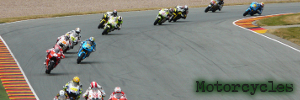















Triumph Daytona |
|---|

|
| Topic Navigation |
|---|
|
Wikipedia: Triumph Daytona 675
Page Sections History Documents |
History
The following section is an excerpt from Wikipedia's Triumph Daytona 675 page on 22 April 2016, text available via the Creative Commons Attribution-ShareAlike 3.0 Unported License.
Triumph Daytona 675
Introduced in 2006, the Triumph Daytona 675 is a three-cylinder sport bike, and the smallest of the Triumph triples. Built by Triumph Motorcycles, it replaced their four-cylinder Daytona 650. The 675 proved to be remarkably light, nimble and powerful, and it was very successful against the Japanese 600cc competition.
Triumph Daytona 675 development started in 2000 following the launch of the four-cylinder TT600. The TT600 was Triumph's first modern middleweight sports motorcycle but it struggled to compete with Japanese 600 cc' supersport motorcycles. So Triumph decided to manufacture a bike closer to its traditional values, making the crucial technical decision to adopt a three-cylinder power plant, instead of a four-cylinder as in the TT600 .
In 2001, soon after the completion of the similarly three cylinder powered Triumph Daytona 955i, Triumph began engineering analysis to work out weight, engine performance in power and torque. Pleased with the figures, the project moved to the full concept phase in March 2002.
Initial chassis development work was done using a chopped Daytona 600 chassis. Triumph moved the wheelbase, adjusted the head angle, and modified the tank. This new configuration exhibited better performance than the original Daytona 600, forming a basis to compare against competitive bikes such as the Kawasaki Ninja ZX-6R and Honda CBR600RR. While engine development had not been completed, computer aided chassis development continued with the data collected from these tests.
Design work for the Daytona 675 proceeded, producing a primarily black design based on the Daytona 600. However, this initial design was discarded as great British designs of the 1960s had "a flowing curved design - no sharp angular aggressive edges". A member of the engineering team produced a concept drawing of the 675 as a naked bike. Styling was based upon this concept drawing and that of the earlier T595 model. Styling development continued in house, staying close to spirit of earlier Triumph design. Market research groups made up of a variety of different classes of sportbike riders chose the latter design of bike which was refined and adopted for production.
The newly developed engine was first tested on a dynamometer in May 2003. Final development combining styling, engine, chassis into a prototype quickly followed. Prototype testing started in late 2004.
The Daytona 675 was officially launched at the NEC International Motorcycle and Scooter Show in 2005. UK-based Bike was given an exclusive test ride prior to the official launch, impressing the magazine test rider. The magazine declared it "the best British sportsbike ever" and "possibly one of the greatest sportsbikes of all time".
The Daytona 675 won the Supersport category for the Masterbike 2006 (finishing third overall), and won again in 2007.
The 2008 model has a dry weight of 363.7 lb (165.0 kg) and wet weight of 407 lb (185 kg). Tested power output is rated at 104.4 hp (77.9 kW) @ 12,100 rpm with torque of 53.3 lbf·ft.
